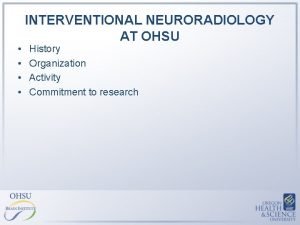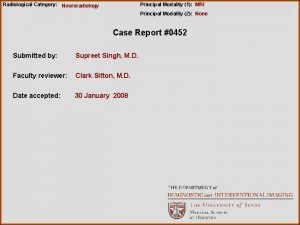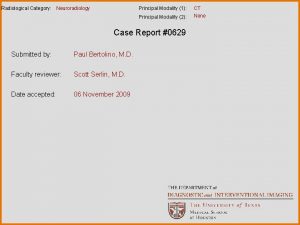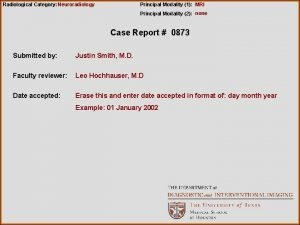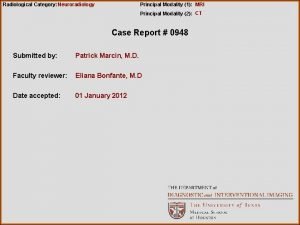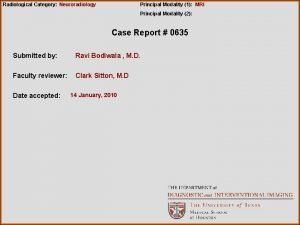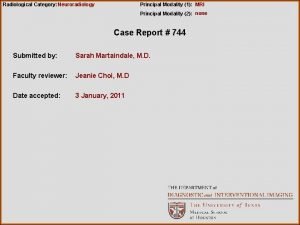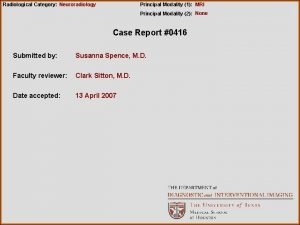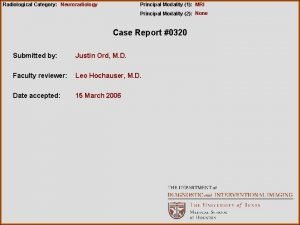Radiological Category Neuroradiology Principal Modality 1 MRI Principal










- Slides: 10

Radiological Category: Neuroradiology Principal Modality (1): MRI Principal Modality (2): CT Case Report #0222 Submitted by: Paul G. Selina, M. D. Faculty reviewer: Leo Hochhauser, M. D. Date accepted: 23 June 2005

Case History An 82 year old Hispanic male presents with a three day history of memory loss, headache, blurred vision, and imbalance.

Radiological Presentations Figure 1. Non-contrast Axial CT of the Brain.

Radiological Presentations FLAIR T 1 Pre-Gd T 1 Post-Gd Figure 2 a. Axial MRI of the Brain.

Radiological Presentations DWI ADC Map Figure 2 b. Axial MRI of the Brain

Test Your Diagnosis Which one of the following is your choice for the appropriate diagnosis? After your selection, go to next page. • Glioblastoma multiforme (GBM; “butterfly glioma”) • CNS Lymphoma • Posterior reversible leukoencephalopathy syndrome (PRES) • Progressive multifocal leukoencephalopathy (PML)

Findings and Differentials Findings: Figure 1. Non-contrast axial CT of the brain reveals mass effect and vasogenic edema involving the parietal and occipital lobes bilaterally, and the corpus callosum. Figure 2 a/2 b. Axial MR images show an enhancing mass that crosses the splenium of the corpus callosum and involves both parietal and occipital lobes. There is surrounding vasogenic edema. In areas of enhancing mass, restricted diffusion is present. Differentials: • CNS Lymphoma • GBM

Discussion The key to making the correct diagnosis in this case is recognizing two important findings. The first is that the disease process involves the corpus callosum. The second is that it exhibits restricted diffusion. Only a few disease entities commonly involve the corpus callosum. The most common are GBM, lymphoma, multiple sclerosis, and acute shearing injuries. Less likely mass lesions involving the corpus callosum include PRES, PML, metastases, adrenoleukodystrophy, Machiafava-Bignami disease, and lipomas. Infarcts don’t usually affect the corpus callosum, possibly due to the presence of bilateral blood supply through the anterior cerebral arteries. High signal on diffusion-weighted imaging (DWI) and low values on apparent diffusion coefficient (ADC) maps, representing restricted diffusion, are also typically seen in only a small number of disease entities. The classic example of restricted diffusion occurs with acute ischemic infarcts. However, it can also be seen associated with cerebral abscess, herpes encephalitis, lymphoma, and hyperacute hemorrhage. Restricted diffusion has been reported in cases of GBM, however, it is not a typical finding. In this case we have an enhancing mass that involves the corpus callosum. This appearance is consistent with either a GBM or CNS Lymphoma.

Discussion However, the finding of restricted diffusion would favor the diagnosis of lymphoma over GBM. The patient underwent an open brain biopsy that revealed non. Hodgkin’s B-cell lymphoma. Further staging work-up revealed no extracranial evidence of lymphoma. Primary CNS lymphoma is an uncommon tumor (1% of all brain tumors) that is becoming more common due to its high incidence in immunocompromised patients, such as those with AIDS. Involvement is usually supratentorial, affecting the basal ganglia, periventricular white matter, and the corpus callosum. Primary disease rarely involves the spine. CNS disease secondary to systemic lymphoma more typically affects the leptomeninges, and commonly involves both the spine and the brain. The type of lymphoma affecting the CNS is usually non-Hodgkin’s B -cell, with Hodgkin’s Disease rarely involving the brain. The tumors are typically hyperdense on non-contrast CT, but may be hypodense, particularly in patients with AIDS. Signal characteristics on T 2 -weighted images are also variable with most tumors being either isointense or hyperintense compared to gray matter. Contrast enhancement on CT and MRI is typically dense and homogeneous, but again can be variable. High signal on DWI and low ADC values are likely due to the dense cellularity typical of lymphoma restricting water diffusion. CNS lymphoma is very radiosensitive, and may even disappear after a short course of steroids.

Diagnosis Primary CNS Non-Hodgkin’s B-cell Lymphoma References: Grossman RI, Yousem DM; Neuroradiology: The Requisites, Second Edition. Mosby, 2003. Weissleder R, Wittenberg J, Harisinghani MG; Primer of Diagnostic Imaging, Third Edition. Mosby, 2003. Stednik TW, et al; Imaging Tutorial: Differential Diagnosis of Bright Lesions on Diffusion -weighted MR Images. Radiographics. 2003; 23: e 7 -e 7
